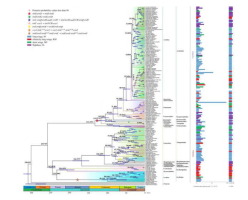当前位置:
X-MOL 学术
›
Mol. Phylogenet. Evol.
›
论文详情
Our official English website, www.x-mol.net, welcomes your
feedback! (Note: you will need to create a separate account there.)
Evolutionary rates of and selective constraints on the mitochondrial genomes of Orthoptera insects with different wing types.
Molecular Phylogenetics and Evolution ( IF 3.6 ) Pub Date : 2020-01-21 , DOI: 10.1016/j.ympev.2020.106734 Huihui Chang 1 , Zhongying Qiu 2 , Hao Yuan 1 , Xiaoyang Wang 1 , Xuejuan Li 1 , Huimin Sun 1 , Xiaoqiang Guo 1 , Yingchun Lu 1 , Xiaolei Feng 1 , Muhammad Majid 1 , Yuan Huang 1
Molecular Phylogenetics and Evolution ( IF 3.6 ) Pub Date : 2020-01-21 , DOI: 10.1016/j.ympev.2020.106734 Huihui Chang 1 , Zhongying Qiu 2 , Hao Yuan 1 , Xiaoyang Wang 1 , Xuejuan Li 1 , Huimin Sun 1 , Xiaoqiang Guo 1 , Yingchun Lu 1 , Xiaolei Feng 1 , Muhammad Majid 1 , Yuan Huang 1
Affiliation

|
Orthoptera is the most diverse order of polyneopterans, and the forewing and hindwing of its members exhibit extremely variability from full length to complete loss in many groups; thus, this order provides a good model for studying the effects of insect flight ability on the evolutionary constraints on and evolutionary rate of the mitochondrial genome. Based on a data set of mitochondrial genomes from 171 species, including 43 newly determined, we reconstructed Orthoptera phylogenetic relationships and estimated the divergence times of this group. The results supported Caelifera and Ensifera as two monophyletic groups, and revealed that Orthoptera originated in the Carboniferous (298.997 Mya). The date of divergence between the suborders Caelifera and Ensifera was 255.705 Mya, in the late Permian. The major lineages of Acrididae seemed to have radiated in the Cenozoic, and the six patterns of rearrangement of 171 Orthoptera mitogenomes mostly occurred in the Cretaceous and Cenozoic. Based on phylogenetic relationships and ancestral state reconstruction, we analysed the evolutionary selection pressure on and evolutionary rate of mitochondrial protein-coding genes (mPCGs). The results indicated that during approximately 300 Mya of evolution, these genes experienced purifying selection to maintain their function. Flightless orthopteran insects accumulated more non-synonymous mutations than flying species and experienced more relaxed evolutionary constraints. The different wing types had different evolutionary rates, and the mean evolutionary rate of Orthoptera mitochondrial mPCGs was 13.554 × 10-9 subs/s/y. The differences in selection pressures and evolutionary rates observed between the mitochondrial genomes suggested that functional constraints due to locomotion play an important role in the evolution of mitochondrial DNA in orthopteran insects with different wing types.
中文翻译:

具有不同翼型的直翅目昆虫线粒体基因组的进化速率和选择性限制。
直翅目是多翅目动物的最多样化的阶,其成员的前翅和后翅在许多群体中从全长到完全丧失都表现出极大的变异性。因此,该顺序为研究昆虫飞行能力对线粒体基因组进化限制和进化速率的影响提供了一个很好的模型。基于来自171个物种(包括新确定的43个物种)的线粒体基因组数据集,我们重建了直翅类的系统发育关系,并估计了该组的发散时间。结果支持Caelifera和Ensifera作为两个单系统种群,并揭示直翅目起源于石炭纪(298.997 Mya)。在二叠纪晚期,Caelifera和Ensifera子亚目之间的分歧日期是255.705 Mya。rid科的主要谱系似乎已在新生代中辐射,171个直翅目有丝分裂基因组的六种重排模式主要发生在白垩纪和新生代。基于系统发育关系和祖先状态重建,我们分析了线粒体蛋白编码基因(mPCGs)的进化选择压力和进化速率。结果表明,在大约300 Mya的进化过程中,这些基因经历了纯化选择,以维持其功能。与飞行物种相比,不会飞行的直翅目昆虫积累了更多的非同义词突变,并且经历了更为宽松的进化限制。不同的机翼类型具有不同的进化速率,直翅目线粒体mPCG的平均进化速率为13.554×10-9 subs / s / y。
更新日期:2020-01-21
中文翻译:

具有不同翼型的直翅目昆虫线粒体基因组的进化速率和选择性限制。
直翅目是多翅目动物的最多样化的阶,其成员的前翅和后翅在许多群体中从全长到完全丧失都表现出极大的变异性。因此,该顺序为研究昆虫飞行能力对线粒体基因组进化限制和进化速率的影响提供了一个很好的模型。基于来自171个物种(包括新确定的43个物种)的线粒体基因组数据集,我们重建了直翅类的系统发育关系,并估计了该组的发散时间。结果支持Caelifera和Ensifera作为两个单系统种群,并揭示直翅目起源于石炭纪(298.997 Mya)。在二叠纪晚期,Caelifera和Ensifera子亚目之间的分歧日期是255.705 Mya。rid科的主要谱系似乎已在新生代中辐射,171个直翅目有丝分裂基因组的六种重排模式主要发生在白垩纪和新生代。基于系统发育关系和祖先状态重建,我们分析了线粒体蛋白编码基因(mPCGs)的进化选择压力和进化速率。结果表明,在大约300 Mya的进化过程中,这些基因经历了纯化选择,以维持其功能。与飞行物种相比,不会飞行的直翅目昆虫积累了更多的非同义词突变,并且经历了更为宽松的进化限制。不同的机翼类型具有不同的进化速率,直翅目线粒体mPCG的平均进化速率为13.554×10-9 subs / s / y。











































 京公网安备 11010802027423号
京公网安备 11010802027423号